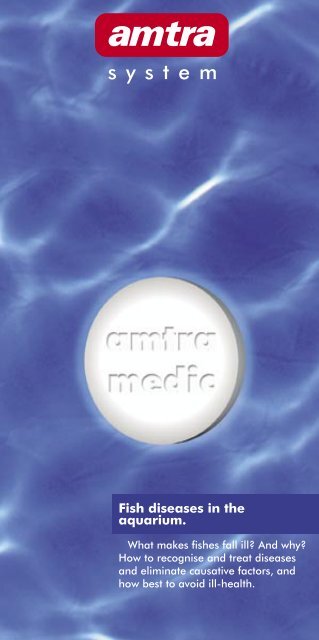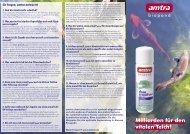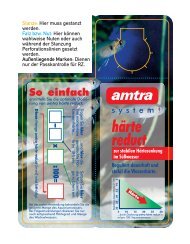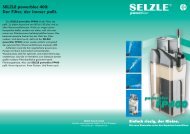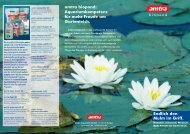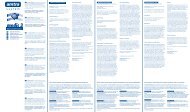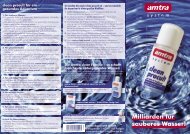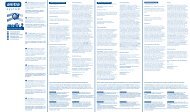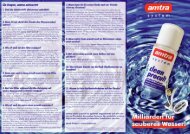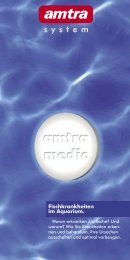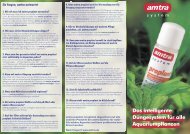Fish diseases in the aquarium. - Amtra
Fish diseases in the aquarium. - Amtra
Fish diseases in the aquarium. - Amtra
Create successful ePaper yourself
Turn your PDF publications into a flip-book with our unique Google optimized e-Paper software.
<strong>Fish</strong> <strong>diseases</strong> <strong>in</strong> <strong>the</strong><br />
<strong>aquarium</strong>.<br />
What makes fishes fall ill? And why?<br />
How to recognise and treat <strong>diseases</strong><br />
and elim<strong>in</strong>ate causative factors, and<br />
how best to avoid ill-health.<br />
1
Healthy fishes mean greater<br />
<strong>aquarium</strong> enjoyment.<br />
How does one go about diagnos<strong>in</strong>g a fish<br />
disease? What is <strong>the</strong> right method of treatment?<br />
And what can be done to prevent<br />
<strong>diseases</strong> from occurr<strong>in</strong>g <strong>in</strong> <strong>the</strong> <strong>aquarium</strong> at<br />
all? On <strong>the</strong> follow<strong>in</strong>g pages Dr. Biffar, one<br />
of <strong>the</strong> very small number of vets <strong>in</strong> Germany<br />
specialis<strong>in</strong>g <strong>in</strong> ornamental fishes, provides<br />
<strong>in</strong>valuable advice on ma<strong>in</strong>ta<strong>in</strong><strong>in</strong>g your fishes<br />
<strong>in</strong> good health so as to obta<strong>in</strong> maximum<br />
enjoyment from your <strong>aquarium</strong>.<br />
The new products <strong>in</strong> <strong>the</strong> amtra medic range provide all aquarists with a<br />
comprehensive "medic<strong>in</strong>e chest" for combatt<strong>in</strong>g all fish <strong>diseases</strong> and symptoms<br />
that can be treated us<strong>in</strong>g freely available active <strong>in</strong>gredients.<br />
Contents<br />
amtra medic page 4<br />
Diseases of ornamental fishes page 5<br />
F<strong>in</strong> damage, clamped f<strong>in</strong>s, etc. page 6<br />
Sk<strong>in</strong> cloud<strong>in</strong>ess, loss of colour, <strong>in</strong>flammation page 8<br />
Distended gillcovers, respiratory distress page 10<br />
Fungus page 12<br />
White spots on <strong>the</strong> sk<strong>in</strong> page 14<br />
Emaciation, white faeces, hole-<strong>in</strong>-head disease page 16<br />
Prevention page 18<br />
2 3
amtra medic<br />
The amtra system provides a comprehensive<br />
"medic<strong>in</strong>e chest" for aquarists.<br />
amtra medic 1 to 5 represent a new generation of medications,<br />
developed by <strong>the</strong> amtra medic program as a complete and<br />
easy-to-use "first aid kit" for treat<strong>in</strong>g all <strong>the</strong> major fish <strong>diseases</strong>.<br />
Unlike traditional medications amtra medic 2, 3, 4 and 5 come<br />
<strong>in</strong> tablet form, conta<strong>in</strong><strong>in</strong>g pure active <strong>in</strong>gredients. It is thus easier<br />
than ever before to treat sick fishes quickly and efficiently. The<br />
dry format ensures far greater stability of <strong>the</strong> active <strong>in</strong>gredients<br />
than <strong>in</strong> liquid medications, and thus guarantees <strong>the</strong>re will be no<br />
deterioration <strong>in</strong> efficacy <strong>in</strong> <strong>the</strong> course of time.<br />
amtra medic 2, 3, and 5 are based on a s<strong>in</strong>gle active <strong>in</strong>gredient<br />
<strong>in</strong> each case. This permits <strong>the</strong> targett<strong>in</strong>g of specific <strong>diseases</strong><br />
without <strong>the</strong> effects, and above all <strong>the</strong> side-effects, of substances<br />
irrelevant to <strong>the</strong> case <strong>in</strong> question. These s<strong>in</strong>gle-<strong>in</strong>gredient preparations<br />
are appreciably better-tolerated, which may mean <strong>the</strong><br />
difference between life and death for seriously weakened fishes.<br />
In <strong>the</strong> event that several different <strong>diseases</strong> are <strong>in</strong>volved, or a<br />
precise diagnosis proves impossible, <strong>the</strong> <strong>in</strong>gredients conta<strong>in</strong>ed <strong>in</strong><br />
amtra medic 2, 3, 4 and 5 can be used toge<strong>the</strong>r, deliberately<br />
and without any risk. This exceptional capacity for comb<strong>in</strong>ation,<br />
not only with each o<strong>the</strong>r but also with prescription drugs (antibiotics<br />
and anti-parasite drugs), has already proved <strong>in</strong>valuable <strong>in</strong><br />
<strong>the</strong> professional sphere.<br />
A significant advantage is that treatment recommendations from<br />
<strong>the</strong> hobby literature are easily followed, as all <strong>the</strong> normal important<br />
agents are to be found <strong>in</strong>dividually <strong>in</strong> a specific product:<br />
Fur<strong>the</strong>rmore, amtra medic products offer a large variety of<br />
additional potential uses. Thus amtra medic 2, which has a<br />
positive effect on <strong>the</strong> oxygen-uptake capability of <strong>the</strong> blood, is<br />
a valuable aid <strong>in</strong> <strong>the</strong> safe and stress-m<strong>in</strong>imised transportation<br />
of fishes, and also prevents egg fungus - a positive benefit to<br />
breeders. amtra medic 3, used at high concentration, can be<br />
used as a highly effective dis<strong>in</strong>fectant for <strong>the</strong> <strong>aquarium</strong> and its<br />
equipment. In addition its exceptional and rapid degradability<br />
m<strong>in</strong>imises any danger to <strong>the</strong> fishes. The same applies to<br />
amtra medic 4.<br />
Diseases of ornamental fishes:<br />
symptoms, treatment, and prevention.<br />
The majority of <strong>diseases</strong> affect<strong>in</strong>g fishes are <strong>in</strong>fectious, caused<br />
by viruses, bacteria, and parasites. If <strong>the</strong>se pathogens multiply <strong>in</strong><br />
vast numbers <strong>in</strong> or on <strong>the</strong> fish, <strong>the</strong>y can cause massive damage to<br />
<strong>the</strong> organism by depriv<strong>in</strong>g it of life-essential substances that <strong>the</strong>y<br />
require for <strong>the</strong>ir own metabolic processes, and/or by produc<strong>in</strong>g<br />
ichthyotoxic substances as a result of those processes. In both<br />
cases <strong>the</strong> health of <strong>the</strong> fish is affected and <strong>the</strong> result is <strong>diseases</strong><br />
manifest<strong>in</strong>g <strong>in</strong> a huge variety of symptoms.<br />
The sooner and more accurately <strong>in</strong>fectious <strong>diseases</strong> can be diagnosed<br />
and treated, <strong>the</strong> greater <strong>the</strong> probability that <strong>the</strong> pathogens<br />
will be successfully elim<strong>in</strong>ated and <strong>the</strong> fish will make a full<br />
recovery. For this reason every aquarist should regard it as his<br />
duty to observe his pets carefully on a regular basis, as only by<br />
<strong>the</strong> early detection of <strong>diseases</strong> and <strong>the</strong> pathogens caus<strong>in</strong>g <strong>the</strong>m<br />
can he hope to combat <strong>the</strong>m successfully and without losses.<br />
fishes<br />
ornamental of Diseases<br />
Recommended agent > amtra product<br />
The commonest symptoms manifest<strong>in</strong>g <strong>in</strong> ornamental fishes are<br />
listed on <strong>the</strong> follow<strong>in</strong>g pages, toge<strong>the</strong>r with <strong>the</strong>ir causes (pathogenic<br />
and o<strong>the</strong>r), suggestions for treatment, and sensible meas-<br />
Malachite green (oxalate)........amtra medic 1<br />
ures for prevention.<br />
Methylene blue........................amtra medic 2<br />
Chloram<strong>in</strong>e T ...........................amtra medic 3<br />
Acriflav<strong>in</strong>e................................amtra medic 4<br />
Metronidazole..........................amtra medic 5<br />
Each amtra medic product represents one of <strong>the</strong> important agents used to treat<br />
<strong>diseases</strong> <strong>in</strong> ornamental fishes.<br />
4 5
F<strong>in</strong> damage, clamped f<strong>in</strong>s, etc.<br />
Symptom 1:<br />
F<strong>in</strong> erosion, f<strong>in</strong> damage, clamped f<strong>in</strong>s.<br />
Angelfish (Pterophyllum scalare) (above) and guppy (Poecilia reticulata) (below) with<br />
clamped dorsal f<strong>in</strong> and a high degree of erosion of <strong>the</strong> caudal f<strong>in</strong>, typical of bacterial<br />
and/or parasitic <strong>in</strong>fection.<br />
Cl<strong>in</strong>ical picture: The f<strong>in</strong>s of most fishes consist of very th<strong>in</strong><br />
membranes, amply supplied with blood-vessels, supported by <strong>the</strong><br />
f<strong>in</strong> skeleton. Numerous pathogens choose to attack <strong>the</strong>se areas.<br />
The result is easily recognisable damage visible as splits <strong>in</strong> <strong>the</strong><br />
membrane and/or superficial cloud<strong>in</strong>g of <strong>the</strong> f<strong>in</strong> edges. These<br />
symptoms are most evident <strong>in</strong> <strong>the</strong> dorsal and caudal f<strong>in</strong>s.<br />
Cause: The commonest causative organisms are bacteria, but<br />
unicellular parasites, especially Ichthyobodo necatrix (Costia), and<br />
sk<strong>in</strong> flukes may parasitise <strong>the</strong> f<strong>in</strong>s and lead to f<strong>in</strong> erosion.<br />
Treatment: Treatment should be achieved us<strong>in</strong>g amtra medic 3<br />
which specifically combats external bacteria and sk<strong>in</strong> flukes. It is<br />
possible to use amtra medic 4 simultaneously or subsequently to<br />
elim<strong>in</strong>ate any possible Costia <strong>in</strong>festation. In cases where fungal<br />
<strong>in</strong>fection has spread to <strong>the</strong> f<strong>in</strong> base <strong>the</strong>n subsequent additional<br />
treatment with amtra medic 2 is recommended.<br />
Prevention: Because <strong>the</strong> delicate f<strong>in</strong> membranes are particularly<br />
sensitive to unsuitable water conditions, <strong>the</strong> latter should be tested<br />
regularly. A sudden drop <strong>in</strong> pH and high levels of metabolic waste<br />
products (such as ammonia and nitrite) are particularly harmful.<br />
It is recommended that <strong>the</strong>se problems are prevented by regular<br />
use of amtra pH-constant to stabilise <strong>the</strong> pH of soft water, and<br />
amtra clean to accelerate detoxification of ammonia and nitrite<br />
<strong>in</strong> all aquaria.<br />
6 7<br />
F<strong>in</strong> damage, clamped f<strong>in</strong>s, etc.
Sk<strong>in</strong> cloud<strong>in</strong>ess, loss of colour, <strong>in</strong>flammation<br />
Symptom 2:<br />
Sk<strong>in</strong> cloud<strong>in</strong>ess, loss of colour, <strong>in</strong>flammation.<br />
Rummy-nose tetra (Hemigrammus bleheri) (above), with clearly visible loss of colour <strong>in</strong><br />
front of <strong>the</strong> caudal peduncle. Armoured catfish (below) with milky discoloration of <strong>the</strong><br />
lower flank below <strong>the</strong> dorsal f<strong>in</strong>.<br />
Cl<strong>in</strong>ical picture: Cloud<strong>in</strong>ess of <strong>the</strong> sk<strong>in</strong> is normally a direct<br />
consequence of <strong>in</strong>creased mucus production by <strong>the</strong> epidermis.<br />
This mucus conceals <strong>the</strong> pigment cells and causes <strong>the</strong> fish to<br />
appear very pale. While this mucus protects <strong>the</strong> fish from harmful<br />
outside <strong>in</strong>fluences, a very thick coat<strong>in</strong>g of mucus can limit <strong>the</strong><br />
essential exchange processes that take place via <strong>the</strong> sk<strong>in</strong> and<br />
gills. Inflammation may result from such disturbances to sk<strong>in</strong><br />
function.<br />
Cause: The same pathogens that <strong>in</strong>itially attack only <strong>the</strong> f<strong>in</strong>s<br />
(see f<strong>in</strong> damage, pp 6-7), may go on to multiply and parasitise<br />
<strong>the</strong> sk<strong>in</strong>. As well as bacteria, sk<strong>in</strong> flukes, and Costia, unicellular<br />
parasites of <strong>the</strong> ciliate group (eg Chilodonella and Trichod<strong>in</strong>a)<br />
may be <strong>in</strong>volved <strong>in</strong> such changes to <strong>the</strong> sk<strong>in</strong>.<br />
Treatment: Ei<strong>the</strong>r amtra medic 3 or amtra medic 4 should be<br />
used for treatment. In particularly severe cases both medications<br />
can be adm<strong>in</strong>istered simultaneously. In <strong>the</strong> event that <strong>the</strong>re is an<br />
improvement, but not a complete cure, after 4 days, treatment<br />
can be repeated after a partial water change.<br />
Prevention: Pathogenic sk<strong>in</strong> <strong>in</strong>fections are particularly likely to<br />
occur where <strong>the</strong> sk<strong>in</strong> is compromised by unsuitable water conditions.<br />
In order to prevent this, <strong>the</strong> water should be treated with<br />
amtra care (conta<strong>in</strong><strong>in</strong>g Polyvidon) at every water change. Fluctuations<br />
<strong>in</strong> pH, which can also harm <strong>the</strong> sk<strong>in</strong> and are particularly<br />
likely <strong>in</strong> very soft water, should be prevented us<strong>in</strong>g amtra pHconstant<br />
(use amtra kh-aktiv <strong>in</strong> harder water). amtra clean<br />
should be used regularly to prevent <strong>the</strong> build-up of toxic<br />
nitrogenous compounds.<br />
8 9<br />
Sk<strong>in</strong> cloud<strong>in</strong>ess, loss of colour, <strong>in</strong>flammation
Distended gillcovers, respiratory distress<br />
Symptom 3:<br />
Distended gillcovers, respiratory distress.<br />
Juvenile firemouth (Thorichthys meeki) exhibit<strong>in</strong>g a high degree of respiratory distress,<br />
caused by a severe <strong>in</strong>festation of gill flukes.<br />
Cl<strong>in</strong>ical picture: Distended gillcovers and "pump<strong>in</strong>g" respiration<br />
with an <strong>in</strong>creased respiratory rate are commonly <strong>the</strong> visible signs<br />
of a gill <strong>in</strong>fection caus<strong>in</strong>g <strong>in</strong>flammation of <strong>the</strong> gill epi<strong>the</strong>lium and<br />
impeded oxygen uptake.<br />
Cause: The gills, with <strong>the</strong>ir blood-rich delicate tissues, are a<br />
favourite site of attack by bacterial and parasitic pathogens.<br />
Flexibacter, flagellates, and gill flukes are typically <strong>in</strong>volved <strong>in</strong><br />
such disease episodes.<br />
Treatment: All potential causes of gill <strong>in</strong>fection can be treated<br />
<strong>in</strong> <strong>the</strong>ir early stages us<strong>in</strong>g amtra medic 4. In advanced cases<br />
amtra medic 3 should be used. A partial water change should<br />
always be made before any repeat dose is adm<strong>in</strong>istered.<br />
Prevention: Because respiratory problems can be caused by<br />
<strong>in</strong>correct water conditions <strong>in</strong> <strong>the</strong> absence of <strong>the</strong> pathogens listed<br />
above, water parameters should always be checked <strong>in</strong> <strong>the</strong> event<br />
of breath<strong>in</strong>g difficulties occurr<strong>in</strong>g. Correct temperature and a<br />
properly function<strong>in</strong>g biological filter (with <strong>the</strong> outflow creat<strong>in</strong>g<br />
movement of <strong>the</strong> water‘s surface) are prerequisites of suitable<br />
conditions.<br />
10 11<br />
Distended gillcovers, respiratory distress
Fungus<br />
Symptom 4:<br />
Fungus.<br />
Catfish (Trachelyichthys sp.) (above) with fungus at <strong>the</strong> base of <strong>the</strong> left-hand pectoral<br />
f<strong>in</strong>. Mailed catfish (Corydoras sodalis) (below) with a cottonwool-like fungus <strong>in</strong>fection at<br />
<strong>the</strong> front of <strong>the</strong> dorsal f<strong>in</strong>.<br />
Cl<strong>in</strong>ical picture: Fungal <strong>in</strong>fections are among <strong>the</strong> most easily<br />
recognisable fish <strong>diseases</strong>. They are symptomised by cottonwoollike<br />
growths which often start at <strong>the</strong> base of a f<strong>in</strong> and can spread<br />
to affect <strong>the</strong> entire body of <strong>the</strong> fish.<br />
Cause: The majority of fungal <strong>in</strong>fections <strong>in</strong> ornamental fishes<br />
are caused by Saprolegnia, but occasionally fungi of <strong>the</strong> genera<br />
Phythium and Achyla may be <strong>in</strong>volved.<br />
Treatment: In <strong>the</strong>ir advanced stages fungal <strong>in</strong>fections can prove<br />
extremely stubborn, requir<strong>in</strong>g very tedious repeated treatment.<br />
For this reason <strong>the</strong> fishes should be kept under constant observation<br />
so that fungal <strong>in</strong>fections can be treated without delay before<br />
<strong>the</strong>y spread. amtra medic 2 as well as amtra medic 4 can<br />
be adm<strong>in</strong>istered for this purpose. In particularly persistent cases<br />
<strong>the</strong> two medications can be used simultaneously to re<strong>in</strong>force <strong>the</strong>ir<br />
effect.<br />
Prevention: Because fungal <strong>in</strong>fections are particularly likely to<br />
attack already-damaged sk<strong>in</strong>, one of <strong>the</strong> most important prerequisites<br />
of prevention is <strong>the</strong> provision of water conditions suited to<br />
<strong>the</strong> species <strong>in</strong> question. For this reason <strong>the</strong> best protection aga<strong>in</strong>st<br />
harmful fungal <strong>in</strong>fections is an efficient conditioner provid<strong>in</strong>g<br />
effective protection for <strong>the</strong> sk<strong>in</strong> mucus (eg amtra care with<br />
Polyvidon). Additional protection can be provided by filtration<br />
over amtra spezial torfgranulat, as <strong>the</strong> hum<strong>in</strong>s released, comb<strong>in</strong>ed<br />
with <strong>the</strong> numerous o<strong>the</strong>r trace substances conta<strong>in</strong>ed <strong>in</strong> this<br />
granulated peat, will limit <strong>the</strong> development of sk<strong>in</strong> fungus.<br />
12 13<br />
Fungus
White spots on <strong>the</strong> sk<strong>in</strong><br />
Symptom 5:<br />
White spots on <strong>the</strong> sk<strong>in</strong>.<br />
The <strong>in</strong>itial stages of white spot disease <strong>in</strong> a striped plec (Peckoltia pulcher) (above),<br />
visible as white spots on <strong>the</strong> upper marg<strong>in</strong> of <strong>the</strong> caudal f<strong>in</strong>. Heavy <strong>in</strong>fection of<br />
Ichthyophthirius multifiliis <strong>in</strong> a juvenile Crenicichla marmorata (below).<br />
Cl<strong>in</strong>ical picture: If <strong>the</strong> fish are seen to huddle toge<strong>the</strong>r <strong>in</strong> a<br />
corner of <strong>the</strong> <strong>aquarium</strong>, or to swim around <strong>the</strong> tank with twitch<strong>in</strong>g<br />
movements, and <strong>the</strong>y are obviously feel<strong>in</strong>g unwell, <strong>the</strong>n on closer<br />
exam<strong>in</strong>ation it is often possible to see t<strong>in</strong>y p<strong>in</strong>head-sized spots<br />
on <strong>the</strong> f<strong>in</strong>s and sk<strong>in</strong>.<br />
Cause: The white spots are <strong>in</strong>dividual specimens of <strong>the</strong> unicellular<br />
parasite Ichthyophthirius multifiliis, which have bored <strong>in</strong>to <strong>the</strong><br />
sk<strong>in</strong> and encysted <strong>the</strong>re. This disease is known as white spot,<br />
after <strong>the</strong> typical symptom, and can be fatal if <strong>the</strong> parasites are<br />
permitted to multiply.<br />
Treatment: It is absolutely essential to beg<strong>in</strong> treatment as soon as<br />
<strong>the</strong> disease is diagnosed, as Ichthyophthirius multifiliis can wipe<br />
out <strong>the</strong> entire population of an <strong>aquarium</strong> <strong>in</strong> a very short time.<br />
Treatment is with amtra medic 1, which should be adm<strong>in</strong>istered,<br />
follow<strong>in</strong>g <strong>the</strong> dosage <strong>in</strong>formation given <strong>in</strong> <strong>the</strong> Instructions for use,<br />
until no more little white spots can be seen on <strong>the</strong> sk<strong>in</strong>.<br />
Prevention: Because Ichthyophthirius multifiliis is an extremely<br />
virulent, and hence particularly dangerous, parasite, it is essential<br />
to avoid all contact between <strong>the</strong> fishes and this pathogen.<br />
For this reason newly-purchased fishes should always be pa<strong>in</strong>stak<strong>in</strong>gly<br />
checked for white spots. In addition, new fishes should if<br />
possible be kept <strong>in</strong> a separate quarant<strong>in</strong>e tank for several days<br />
and observed closely, before <strong>the</strong>y are <strong>in</strong>troduced <strong>in</strong>to <strong>the</strong> ma<strong>in</strong><br />
<strong>aquarium</strong>.<br />
14 15<br />
White spots on <strong>the</strong> sk<strong>in</strong>
Emaciation, white faeces, hole-<strong>in</strong>-head disease<br />
Symptom 6:<br />
Emaciation, white faeces, and hole-<strong>in</strong>-head disease.<br />
Advanced hole-<strong>in</strong>-head disease <strong>in</strong> a Crenicichla sp. "X<strong>in</strong>gu" (above). Wild-caught green<br />
discus (Symphysodon aequifasciatus aequifasciatus) (below), emaciated as a result of a<br />
massive attack by Hexamita.<br />
Cl<strong>in</strong>ical picture: The various cichlid species <strong>in</strong> particular are<br />
prone to illnesses where s<strong>in</strong>gle specimens feed less well, lose condition,<br />
and become emaciated. On closer <strong>in</strong>spection <strong>the</strong> faeces<br />
are sometimes seen to be white and hang from <strong>the</strong> anus <strong>in</strong><br />
"str<strong>in</strong>gs". Sometimes pitted holes appear <strong>in</strong> <strong>the</strong> sk<strong>in</strong> above <strong>the</strong><br />
eyes, extend<strong>in</strong>g <strong>in</strong>to <strong>the</strong> tissue below.<br />
Cause: The ma<strong>in</strong> causes of this disease syndrome are as a<br />
rule unicellular parasites of <strong>the</strong> flagellate group, <strong>in</strong> particular<br />
Hexamita, but also Cryptobia and Protoopal<strong>in</strong>a (which primarily<br />
parasitises discus). These parasites are found <strong>in</strong> <strong>the</strong> gut, and <strong>in</strong><br />
particularly severe cases <strong>in</strong> <strong>the</strong> liver and spleen as well. The holes<br />
that appear dur<strong>in</strong>g hole-<strong>in</strong>-head disease are usually diagnosed<br />
as be<strong>in</strong>g caused by Hexamita.<br />
Treatment: Prompt treatment with amtra medic 5 can prevent<br />
<strong>the</strong> parasites from spread<strong>in</strong>g from <strong>the</strong> gut to <strong>the</strong> liver and spleen,<br />
and hence avoid <strong>the</strong> associated severe progressive wast<strong>in</strong>g and<br />
emaciation. Hole-<strong>in</strong>-head disease, <strong>in</strong> which <strong>the</strong> flagellates are<br />
only one of a number of causes, should also be treated with<br />
amtra medic 5 but <strong>in</strong> comb<strong>in</strong>ation with m<strong>in</strong>eral-rich food<br />
(eg amtra sano basic).<br />
Prevention: Intest<strong>in</strong>al flagellates will f<strong>in</strong>d an environment suitable<br />
for uncontrolled proliferation only when <strong>the</strong> normal <strong>in</strong>test<strong>in</strong>al flora<br />
has been compromised. The commonest cause of this is unsuitable<br />
and <strong>in</strong>digestible food. Regular feed<strong>in</strong>g with <strong>the</strong> m<strong>in</strong>eral-rich<br />
and easily digestible natural food materials conta<strong>in</strong>ed <strong>in</strong> amtra<br />
sano can largely prevent Hexamita <strong>in</strong>fection. Even <strong>in</strong> <strong>the</strong> case<br />
of a pre-exist<strong>in</strong>g <strong>in</strong>fection <strong>the</strong> progress of <strong>the</strong> disease can be<br />
significantly and positively <strong>in</strong>fluenced by appropriate feed<strong>in</strong>g.<br />
16 17<br />
Emaciation, white faeces, hole-<strong>in</strong>-head disease
Prevention<br />
Prevention is <strong>the</strong> best medic<strong>in</strong>e.<br />
There are many different reasons why ornamental fishes become<br />
ill. Often <strong>the</strong>se causes are l<strong>in</strong>ked and have a reciprocal effect on<br />
each o<strong>the</strong>r. They <strong>in</strong>clude stressors such as unsuitable water parameters,<br />
tox<strong>in</strong>s <strong>in</strong> <strong>the</strong> water, genetic defects, errors <strong>in</strong> ma<strong>in</strong>tenance<br />
(such as a monotonous or unsuitable diet), and, of course, <strong>the</strong><br />
presence of potentially pathogenic organisms.<br />
As a rule, however, fishes do not become unwell unless pathogens<br />
are able to multiply out of hand on <strong>the</strong> sk<strong>in</strong> and/or gills or <strong>in</strong><br />
<strong>the</strong> <strong>in</strong>ternal organs. And this is possible only where unsuitable<br />
conditions – so-called stressors – have affected <strong>the</strong> immune<br />
system of <strong>the</strong> fish. Additional dangerous stressors <strong>in</strong>clude pH<br />
collapse, an unsuitable social structure <strong>in</strong> <strong>the</strong> <strong>aquarium</strong>, and<br />
equipment failure (eg defective filters or heaters). Under such<br />
circumstances pathogens can multiply explosively and very quickly<br />
come to represent a serious threat to <strong>the</strong> health, and even <strong>the</strong><br />
lives, of <strong>the</strong> fishes.<br />
Diseases <strong>in</strong> ornamental fishes can be treated successfully only if<br />
<strong>the</strong> causes of stress are removed <strong>in</strong> addition to combat<strong>in</strong>g <strong>the</strong><br />
pathogen responsible with an appropriate medication. Because<br />
outbreaks of disease <strong>in</strong> ornamental fishes are generally <strong>the</strong> result<br />
of unsuitable water conditions, it is important to pay special<br />
attention to condition<strong>in</strong>g <strong>the</strong> water, for example us<strong>in</strong>g amtra<br />
care, amtra spezial torfgranulat, and/or amtra ultra carbon.<br />
In addition <strong>the</strong> metabolic wastes deriv<strong>in</strong>g from both fishes and<br />
plants must be biologically processed before <strong>the</strong>y pollute <strong>the</strong><br />
water excessively – for example by <strong>the</strong> addition of amtra clean.<br />
No less important is <strong>the</strong> provision of water parameters that are as<br />
natural as possible for <strong>the</strong> fishes concerned, us<strong>in</strong>g products such<br />
as amtra eichenextrakt, amtra trop, amtra ph-constant, and<br />
amtra kh-aktiv. In general, optimal water parameters are not<br />
only extremely important for prophylaxis, but are also absolutely<br />
essential <strong>in</strong> <strong>the</strong> event of disease occurr<strong>in</strong>g, as fishes can recover<br />
completely only if <strong>the</strong>ir environment is near-perfect.<br />
In <strong>the</strong> event of disease occurr<strong>in</strong>g <strong>the</strong> diet of <strong>the</strong> fishes should also<br />
be considered particularly critically, especially as <strong>the</strong> quality of <strong>the</strong><br />
food has an immediate effect on <strong>the</strong> function of <strong>the</strong> liver – and<br />
hence on <strong>the</strong> effective basis of <strong>the</strong> entire immune system of <strong>the</strong><br />
fish. It is a sad fact that even today <strong>the</strong>re are still huge deficiencies<br />
<strong>in</strong> <strong>the</strong> field of ornamental fish nutrition, as evidenced by <strong>the</strong> very<br />
large number of fishes found to have severe fatty<br />
degeneration of <strong>the</strong> liver dur<strong>in</strong>g veter<strong>in</strong>ary post-mortem. Responsible<br />
aquarists should <strong>the</strong>refore endeavour to offer <strong>the</strong>ir fishes a<br />
diet as close as possible to that enjoyed <strong>in</strong> nature, for example<br />
carefully-prepared deep-frozen foods such as amtra frost and<br />
amtra sano.<br />
Last but not least <strong>the</strong>re are a few o<strong>the</strong>r essential products which<br />
will encourage and ma<strong>in</strong>ta<strong>in</strong> good health <strong>in</strong> your fishes <strong>in</strong> a<br />
natural manner. Additional tips on this subject will be found <strong>in</strong> <strong>the</strong><br />
earlier sections on <strong>the</strong> various <strong>diseases</strong>, <strong>in</strong> <strong>the</strong> recommendations<br />
regard<strong>in</strong>g <strong>the</strong> provision of healthy water parameters:<br />
amtra clean<br />
Activates biological<br />
self-purification of <strong>the</strong><br />
water, by enrich<strong>in</strong>g it<br />
with beneficial microorganisms.<br />
Saves up to<br />
50% on water changes.<br />
amtra care<br />
Transforms <strong>the</strong> ma<strong>in</strong>s<br />
supply <strong>in</strong>to water safe<br />
for <strong>the</strong> <strong>aquarium</strong>. And<br />
protects <strong>the</strong> gills and<br />
mucus coat<strong>in</strong>g via natural<br />
protective colloids.<br />
amtra eichenextrakt<br />
Lowers <strong>the</strong> pH for<br />
softwater ornamental<br />
fishes. And <strong>in</strong> addition<br />
stabilises sk<strong>in</strong> function<br />
and counters "dark coloration<br />
syndrome" <strong>in</strong><br />
discus.<br />
amtra trop<br />
Lowers hardness (GH)<br />
for softwater<br />
ornamental fishes. Prevents<br />
dangerous drops <strong>in</strong><br />
pH. Comb<strong>in</strong>es well with<br />
amtra eichenextrakt.<br />
amtra pH-constant<br />
Stabilises <strong>the</strong> pH, even<br />
with high population<br />
densities and heavy<br />
feed<strong>in</strong>g. Also suitable for<br />
reverse-osmosis and deionised<br />
water.<br />
amtra kh-aktiv<br />
Increases <strong>the</strong> carbonate<br />
hardness (KH) for<br />
hardwater ornamental<br />
fishes. Provides an<br />
effective safeguard<br />
aga<strong>in</strong>st falls <strong>in</strong> pH, which<br />
might o<strong>the</strong>rwise seriously<br />
endanger <strong>the</strong> occupants<br />
of <strong>the</strong> <strong>aquarium</strong>.<br />
amtra ultra carbon<br />
Highly effective activated<br />
carbon for<br />
freshwater and<br />
mar<strong>in</strong>e aquaria. This<br />
filter material optimally<br />
b<strong>in</strong>ds up heavy metals<br />
and o<strong>the</strong>r pollutants, and<br />
offers <strong>the</strong> best results as<br />
regards remov<strong>in</strong>g discoloration<br />
and medication<br />
residues.<br />
amtra spezial<br />
torfgranulat<br />
For creat<strong>in</strong>g tropical<br />
blackwater conditions<br />
<strong>in</strong> fresh water. Natural<br />
black peat concentrate<br />
with hum<strong>in</strong>s and valuable<br />
trace elements.<br />
18 19<br />
18 19<br />
Prevention
20<br />
The amtra system for greater <strong>aquarium</strong> enjoyment comprises<br />
carefully developed, scientifically tested, and optimally<br />
matched products, with whose aid you can easily,<br />
conveniently, and above all confidently create ideal liv<strong>in</strong>g<br />
conditions for your fishes and plants.<br />
amtra Aquaristik GmbH<br />
Liebigstrasse 1 • D-63110 Rodgau<br />
www.amtra.de • <strong>in</strong>fo@amtra.de<br />
Order no. VV036


